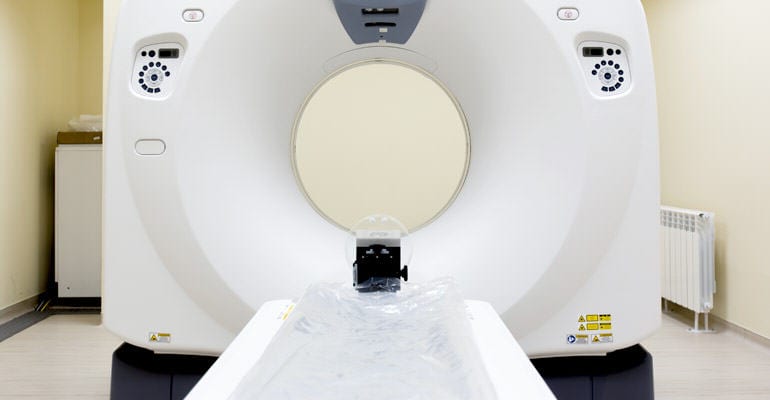In medicine, accurate testing for illnesses can be lifesaving. Positron Emission Tomography (or PET) scans allow doctors to do just that: Save lives. PET scans work quickly to check brain function, identify cancerous tumors, and measure blood flow. Although PET scans are only a relatively recent technology, they have already proven themselves absolutely essential – especially in diagnosing and monitoring cancers. With fast and accurate testing, doctors can treat cancers early and learn immediately if a cancer reoccurs.
How a PET Scan Works
Before a PET scan, a radiologist gives a patient a small amount of radioactive material, called a “tracer.” The tracer is mixed with glucose (a type of sugar) so it can be absorbed into the body as energy for the cells. Usually the tracer is injected into a vein, but in some cases, such as certain brain PET scans, the patient might inhale a gas instead.
The tracer then travels through the blood and collects in the organs and tissues. As the tracer moves through the body, it may encounter cancer cells. The tracer will be able to identify these, because cancer cells use more energy than healthy cells, which means they will absorb more of the tracer.
When radiologists use a special camera, the areas that absorbed the most radioactive material are highlighted on a computer screen. This allows doctors to locate tumors, as well as any areas where blood flow is blocked, which could be caused by an infection or a brain disorder.
The Invention of PET Scans
In 2001, Dr. Ron Nutt and Dr. David Townsend revolutionized medicine by creating the first hybrid PET/CT scanner, but early experiments with scanners go back several decades. Scientists have been studying how cells breakdown radioactive material since the 19th century. In the 1950s, physicist Gordon Brownell and neurosurgeon William Sweet at Massachusetts General Hospital used this knowledge to identify brain tumors with the first PET scan.
In early PET scans, the images produced were low-quality and 2-dimensional, as opposed to the 3D models created by modern PET scanners. The PET scanners doctors use today have accurate and clear imaging power thanks to advances in computer technology. This allows doctors to have a better look at what is going on inside the body and more accurately diagnose illnesses.
Uses of Modern PET Scans
PET scans are a safe and effective way to detect many types of cancer. For certain cancers, such as malignant mesothelioma, tests are more accurate when combined with a CT scan. In some cases, inflammation of the pleura – the lining of the lung – can be mistaken for cancer on a PET scan. One case study found that a combined PET and CT scan correctly identified the difference between benign (non-cancerous) pleural disease and mesothelioma in 13 of 14 patients.
A PET scan may also be used to:
- Find signs of epilepsy, Alzheimer Disease, or other brain disorders
- Detect cancer or infection
- Determine if cancer has spread
- Find areas where there may be poor blood flow to the heart
- Determine if a lung mass is cancerous or benign
- Chart the success of cancer treatment
Preparing for Your PET Scan Procedure
A PET scan is a noninvasive test, meaning it involves no surgery. However, you will still have to prepare ahead of time. Before your PET scan, you will be asked not to eat or drink anything for 4 to 6 hours. Some medications, such as those used for diabetes, may interfere with test results, so you should let your doctors know about any medications you are using, including over-the-counter drugs, vitamins, and herbal remedies.
Have you seen a PET scan machine before? Many people describe it as a giant doughnut with a table sitting inside it. You will lie still inside the machine for 30 to 60 minutes while a camera takes 3 dimensional pictures. The test is painless, but you should consult your doctors if you have a fear of enclosed spaces. There is no recovery time, and you can go home the same day.
The radiologist who performs your PET scan can usually discuss some of your results right away. Doctors will then review the images sometime in the next 48 hours and give you more thorough results. For fast-acting cancers, like mesothelioma, the quick diagnosis provided by a PET scan can mean earlier treatment and a better survival rate.










